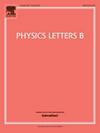宇宙弦时空中的圆柱形边界感应电流
IF 4.5
2区 物理与天体物理
Q1 ASTRONOMY & ASTROPHYSICS
引用次数: 0
摘要
本文研究了理想宇宙弦时空中由圆柱形边界引起的带电玻色子场算子的真空电流。在这种设置中,我们假设圆柱形边界与弦同轴,而弦又沿其核心携带磁通量。为了进行这种分析,我们计算了边界内外两个区域的正频率Wightman函数。此外,我们假设玻色子场在圆柱壳上符合Robin边界条件。利用这种方法,给出了真空玻色子电流的解析表达式,其形式为无边界部分和边界诱导部分之和。因为无边界贡献在文献中已经很好地建立起来了,所以我们这里的重点是与边界相关的部分。正如我们将看到的,我们的一般结果是在圆柱对称静态结构中提出的。研究了边界感应真空电流在各种极限情况下的渐近性质。为了更好地理解这些电流,我们提供了一些图表,展示了它们的行为,作为到弦核心距离的函数,以及沿着它运行的磁通量强度。这些图还显示了与平面角度亏缺相关的参数如何干扰相应电流的强度。本文章由计算机程序翻译,如有差异,请以英文原文为准。
Cylindrical boundary induced current in the cosmic string spacetime
In this paper we investigate the vacuum current associated with a charged bosonic field operator, induced by a cylindrical boundary in the idealized cosmic string spacetime. In this setup we assume that the cylindrical boundary is coaxial with the string, that by its turn carry a magnetic flux along its core. In order to develop this analysis, we calculate the positive frequency Wightman functions for both regions, inside and outside the boundary. Moreover, we assume that the bosonic field obeys the Robin boundary condition on the cylindrical shell. Using this approach, the analytical expressions for the vacuum bosonic currents are presented in the form of the sum of boundary-free and boundary-induced parts. Because the boundary-free contribution is very well established in literature, our focus here is in the boundary-dependent part. As we will see, our general results are presented in a cylindrically symmetric static structure. Some asymptotic behaviors for the boundary-induced vacuum currents are investigated in various limiting cases. In order to provide a better understanding of these currents, we provide some graphs exhibiting their behavior as function of the distance to the string’s core, and on the intensity of the magnetic flux running along it. These plots also present how the parameter associated with the planar angle deficit interfere in the intensity of the corresponding current.
求助全文
通过发布文献求助,成功后即可免费获取论文全文。
去求助
来源期刊

Physics Letters B
物理-物理:综合
CiteScore
9.10
自引率
6.80%
发文量
647
审稿时长
3 months
期刊介绍:
Physics Letters B ensures the rapid publication of important new results in particle physics, nuclear physics and cosmology. Specialized editors are responsible for contributions in experimental nuclear physics, theoretical nuclear physics, experimental high-energy physics, theoretical high-energy physics, and astrophysics.
 求助内容:
求助内容: 应助结果提醒方式:
应助结果提醒方式:


